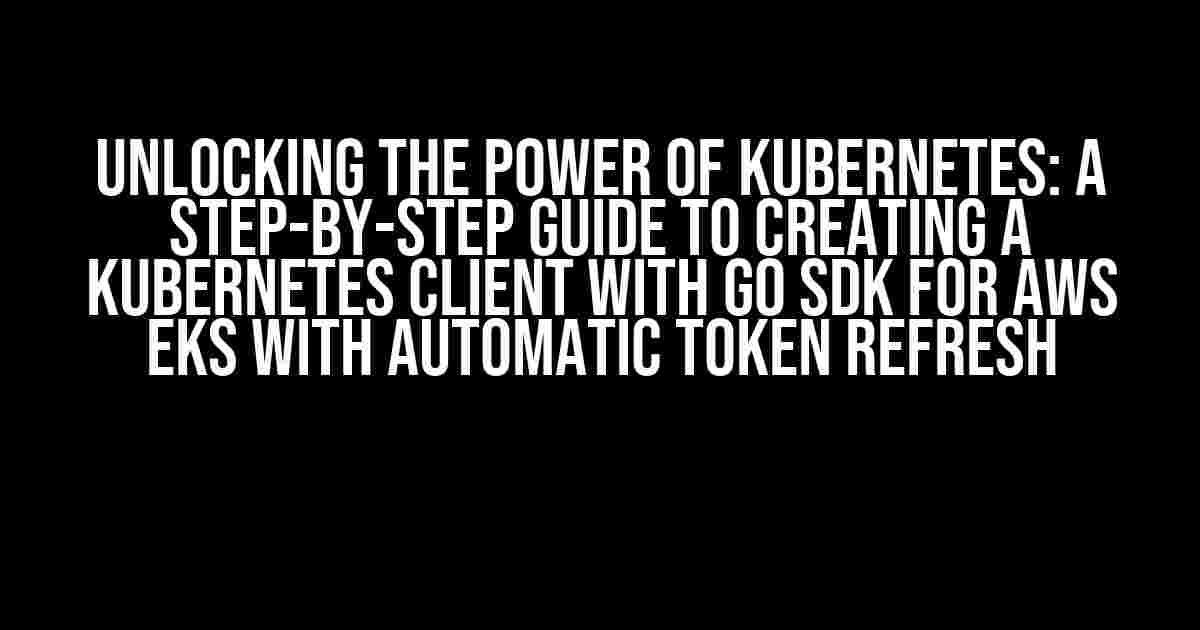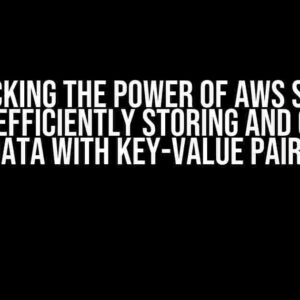In the world of cloud computing, Kubernetes has become the de facto standard for container orchestration. Amazon Web Services (AWS) offers a managed Kubernetes service called Amazon Elastic Container Service for Kubernetes (EKS), making it easier to deploy and manage containerized applications. However, to interact with EKS, you need a Kubernetes client. In this article, we’ll explore how to create a Kubernetes client using the Go SDK, complete with automatic token refresh, to seamlessly interact with your EKS cluster.
Prerequisites
Before we dive into the implementation, make sure you have the following prerequisites in place:
- AWS account with EKS cluster setup
- Go programming language installed on your machine (version 1.17 or later)
- AWS CLI configured with your EKS cluster credentials
- Kubernetes Go SDK installed (we’ll cover this in the next section)
Installing the Kubernetes Go SDK
To create a Kubernetes client using Go, you need to install the Kubernetes Go SDK. You can do this using the following command:
go get -u k8s.io/client-go/...This command will fetch the latest version of the Kubernetes Go SDK and its dependencies.
Creating a Kubernetes Client with Go SDK
Now that you have the Kubernetes Go SDK installed, let’s create a simple Kubernetes client using Go.
package main
import (
"context"
"fmt"
metav1 "k8s.io/apimachinery/pkg/apis/meta/v1"
"k8s.io/client-go/kubernetes"
"k8s.io/client-go/rest"
)In this code snippet, we’re importing the necessary packages, including the Kubernetes Go SDK. The main function will create a new Kubernetes client:
func main() {
// Create a new Kubernetes client
config, err := rest.InClusterConfig()
if err != nil {
fmt.Println(err)
return
}
clientset, err := kubernetes.NewForConfig(config)
if err != nil {
fmt.Println(err)
return
}
// Get a list of nodes
nodes, err := clientset.CoreV1().Nodes().List(context.TODO(), metav1.ListOptions{})
if err != nil {
fmt.Println(err)
return
}
// Print the node names
for _, node := range nodes.Items {
fmt.Println(node.Name)
}
}This code creates a new Kubernetes client using the `kubernetes.NewForConfig()` function, which takes a `rest.Config` object as an argument. We’re using the `rest.InClusterConfig()` function to create a `rest.Config` object that points to the EKS cluster.
Configuring the Kubernetes Client for AWS EKS
To use the Kubernetes client with your EKS cluster, you need to configure it with your AWS credentials and EKS cluster endpoint. Create a new file called `aws.go` with the following content:
package main
import (
"context"
"fmt"
"log"
"github.com/aws/aws-sdk-go/aws"
"github.com/aws/aws-sdk-go/aws/session"
"k8s.io/client-go/rest"
"k8s.io/client-go/tools/clientcmd"
)In this file, we’re importing the necessary packages, including the AWS SDK for Go and the Kubernetes Go SDK. The `getCredentials()` function will retrieve your AWS credentials:
func getCredentials() (*aws.Credentials, error) {
sess, err := session.NewSession(&aws.Config{Region: aws.String("your-region")}, nil)
if err != nil {
return nil, err
}
creds, err := sess.Credentials.Get()
if err != nil {
return nil, err
}
return creds, nil
}The `getEKSConfig()` function will create a `rest.Config` object with your EKS cluster endpoint and credentials:
func getEKSConfig(creds *aws.Credentials) (*rest.Config, error) {
clusterName := "your-eks-cluster-name"
region := "your-region"
config, err := rest.InClusterConfig()
if err != nil {
return nil, err
}
// Set the EKS cluster endpoint
endpoint, err := getEKSAPIEndpoint(clusterName, region)
if err != nil {
return nil, err
}
config.Host = endpoint
// Set the AWS credentials
config.TLSClientConfig.CertData = creds.GetCredential().Certificate
config.TLSClientConfig.KeyData = creds.GetCredential().PrivateKey
return config, nil
}The `getEKSAPIEndpoint()` function will retrieve the EKS cluster endpoint using the AWS SDK for Go:
func getEKSAPIEndpoint(clusterName string, region string) (string, error) {
svc := eks.New(session.New())
input := &eks.DescribeClusterInput{
Name: aws.String(clusterName),
}
result, err := svc.DescribeCluster(context.TODO(), input)
if err != nil {
return "", err
}
return *result.Cluster.Endpoint, nil
}Now, let’s update the `main()` function in the previous code snippet to use the `getEKSConfig()` function:
func main() {
// Get AWS credentials
creds, err := getCredentials()
if err != nil {
log.Fatal(err)
}
// Get EKS config
eksConfig, err := getEKSConfig(creds)
if err != nil {
log.Fatal(err)
}
// Create a new Kubernetes client
clientset, err := kubernetes.NewForConfig(eksConfig)
if err != nil {
log.Fatal(err)
}
// Get a list of nodes
nodes, err := clientset.CoreV1().Nodes().List(context.TODO(), metav1.ListOptions{})
if err != nil {
log.Fatal(err)
}
// Print the node names
for _, node := range nodes.Items {
fmt.Println(node.Name)
}
}In this updated code, we’re using the `getEKSConfig()` function to create a `rest.Config` object with your EKS cluster endpoint and credentials. We then pass this `rest.Config` object to the `kubernetes.NewForConfig()` function to create a new Kubernetes client.
Implementing Automatic Token Refresh
To implement automatic token refresh, we’ll use the `token` package from the Kubernetes Go SDK. Create a new file called `token.go` with the following content:
package main
import (
"context"
"fmt"
"time"
"k8s.io/client-go/token"
)In this file, we’ll create a `tokenManager` struct to manage the token refresh:
type tokenManager struct {
tokenGetter *token.GetToken
client *http.Client
}The `tokenManager` struct has two fields: `tokenGetter`, which is used to get the token from the EKS cluster, and `client`, which is an HTTP client used to send requests to the EKS cluster.
func (t *tokenManager) GetToken(ctx context.Context) (*token.Token, error) {
token, err := t.tokenGetter.GetToken(ctx)
if err != nil {
return nil, err
}
// Refresh the token if it's near expiration
если token.Expiration.Before(time.Now().Add(30 * time.Second)) {
token, err = t.tokenGetter.GetToken(ctx)
if err != nil {
return nil, err
}
}
return token, nil
}In the `GetToken()` function, we’re using the `tokenGetter` to get the token from the EKS cluster. We’re also checking if the token is near expiration and refreshing it if necessary.
Now, let’s update the `main()` function to use the `tokenManager` struct:
func main() {
// Get AWS credentials
creds, err := getCredentials()
if err != nil {
log.Fatal(err)
}
// Get EKS config
eksConfig, err := getEKSConfig(creds)
if err != nil {
log.Fatal(err)
}
// Create a token manager
tokenManager := &tokenManager{
tokenGetter: &token.GetToken{
Config: eksConfig,
},
client: &http.Client{},
}
// Create a new Kubernetes client with token manager
clientset, err := kubernetes.NewForConfig(tokenManager)
if err != nil {
log.Fatal(err)
}
// Get a list of nodes
nodes, err := clientset.CoreV1().Nodes().List(context.TODO(), metav1.ListOptions{})
if err != nil {
log.Fatal(err)
}
// Print the node names
for _, node := range nodes.Items {
fmt.Println(node.Name)
}
}In this updated code, we’re creating a `tokenManager` struct and passing it to the
Frequently Asked Questions
Get ready to dive into the world of Kubernetes and AWS EKS with automatic token refresh using Go SDK!
Q1: What are the prerequisites to create a Kubernetes client with Go SDK for AWS EKS?
To get started, you’ll need to have Go installed on your machine, along with the AWS EKS cluster and the necessary credentials to access it. You’ll also need to install the required Go packages, including the Kubernetes Go client and the AWS SDK for Go. Make sure you have the correct version of Go and the necessary dependencies installed.
Q2: How do I import the required Go packages for creating a Kubernetes client with automatic token refresh?
To import the required packages, you’ll need to add the following lines to your Go file: import ( "context" "fmt" "log" "time" "github.com/aws/aws-sdk-go/aws" "github.com/aws/aws-sdk-go/aws/session" "k8s.io/apimachinery/pkg/util/wait" "k8s.io/client-go/kubernetes" "k8s.io/client-go/rest" ). These packages will allow you to create a Kubernetes client with automatic token refresh using the AWS SDK for Go.
Q3: How do I create a Kubernetes client with automatic token refresh using the AWS SDK for Go?
To create a Kubernetes client with automatic token refresh, you’ll need to create an AWS session using the AWS SDK for Go, and then use the k8s.io/client-go/rest package to create a Kubernetes client. You can use the aws.STSSessionTokenProvider to provide the token, and the k8s.io/client-go/rest package will automatically refresh the token when it expires.
Q4: How do I handle errors and retries when creating a Kubernetes client with automatic token refresh?
When creating a Kubernetes client with automatic token refresh, you’ll need to handle errors and retries using the k8s.io/apimachinery/pkg/util/wait package. You can use the wait.ExponentialBackoff function to implement an exponential backoff retry strategy, which will help you handle transient errors and timeouts.
Q5: What are some best practices to keep in mind when creating a Kubernetes client with automatic token refresh?
Some best practices to keep in mind when creating a Kubernetes client with automatic token refresh include using a secure way to store your AWS credentials, implementing proper error handling and retries, and using a robust logging mechanism to track your client’s activity. Additionally, make sure to follow the principle of least privilege when creating your AWS IAM roles and permissions.



